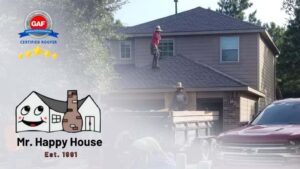
Best GAF Certified Roofers in The Woodlands, TX – Quality Roof Replacement, Gutters & Siding
Best GAF Certified Roofers in The Woodlands, TX – Quality Roof Replacement, Gutters & Siding Best GAF Certified Roofers in The Woodlands, TX – Quality
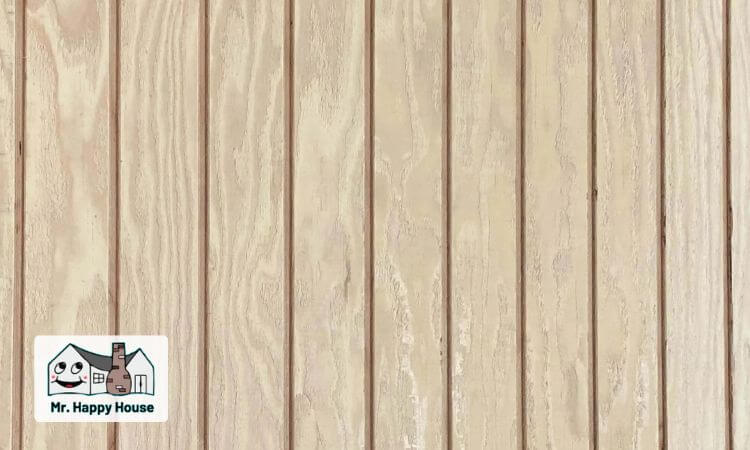
You’ve probably heard of T1-11 siding, a once-popular choice for home exteriors. However, as experts in the industry, we at Mr. Happy House have taken a closer look at T1-11 siding, and we’re here to share with you some of its drawbacks, that can be quite catastrophic in some cases. We are going to mention as well a far superior alternative for siding on your home’s exterior.
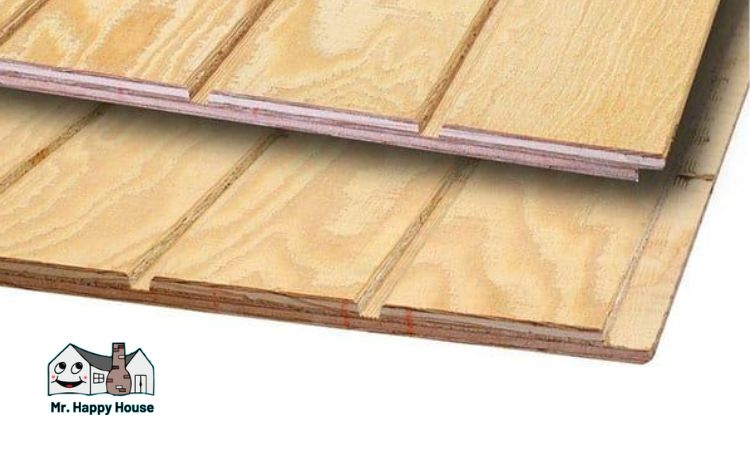
In the 1960s to 1980s, T1-11 siding enjoyed widespread use. This plywood-based siding was seen as an economical and easy-to-install option for homeowners. The name ‘T1-11’ itself reflects its unique design, with the ‘T’ standing for ‘textured’ – a nod to its distinctive vertical grooves. Made from OSB (Oriented Strand Board) or softwood plywood, T1-11 was a product of wood fragments bonded under heat and pressure.
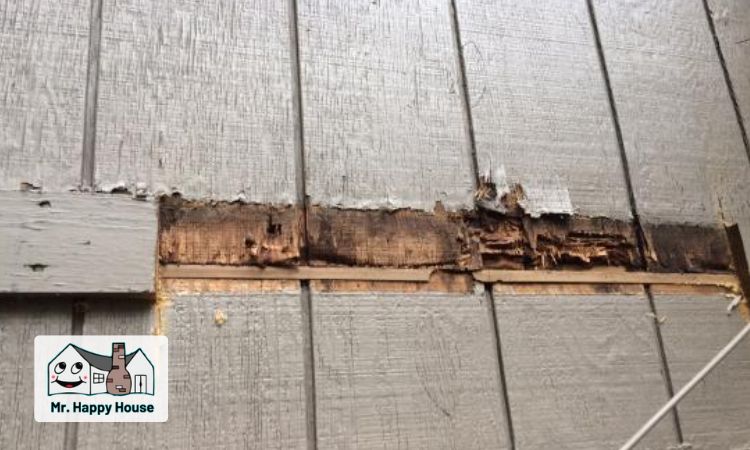
It is almost always recommended to remove old siding before placing new siding on a house, and this will be factored into the overall cost of the project. It is important to note that the elements in Houston can be extremely harsh on the siding of a house compared to other climates in the United States.
The older and more worn or damaged the old siding is the more it can cost to remove the siding. Think about how easy it is to remove a new nail or screw versus one that has rusted and may be warped.
Now, why is it recommended to remove the old siding? By removing the old siding, a professional contractor can look for water damage, pest infestations, and more. One of the benefits of having a trained professional remove the old siding from your home is that they are trained to spot underlying issues that many homeowners would not notice.
Our team at Mr. Happy House is always a phone call away. We are local to the Northwest Houston area and we can remove old siding, spot underlying issues, and place beautiful new siding on any home.
First and foremost, T1-11 siding falls short in its resistance to weather elements. Over time, exposure to moisture can cause the siding to swell and buckle, leading to unsightly distortions in the home exterior. Moreover, consistent moisture exposure can cause the wood to rot, compromising the structural integrity of the siding.
For homeowners, this means a perpetual cycle of maintenance: sealing, painting, and ultimately, replacement. This adds unnecessary cost and effort, diminishing the initial cost-saving benefits of T1-11 siding.
Furthermore, T1-11 siding has proven to be quite attractive to certain types of insects. Termites and carpenter ants are particularly drawn to this type of wood, often causing extensive damage that can go unnoticed until significant harm has been done.
These combined factors make T1-11 siding a less-than-ideal option for homeowners looking for a long-lasting, low-maintenance solution for their home exteriors.
As we steer away from T1-11 siding, we look towards a highly recommended alternative – James Hardie siding, or fiber-cement siding. This siding option has surged in popularity in recent years, and for good reason.
While James Hardie siding offers a range of advantages, it’s worth noting that the installation process requires skilled workmanship. The material is heavier than T1-11 siding, and cutting it requires specialized tools to prevent dust. However, these considerations should not deter homeowners. The slight additional labor cost is offset by the long-term benefits that James Hardie siding provides.
Working with an experienced contractor is key to ensuring proper installation with James Hardie Siding. At Mr. Happy House, our team is skilled in the installation of James Hardie siding in The Woodlands, TX, providing homeowners with the assurance of a job well done. Once installed, James Hardie siding offers a seamless look that enhances your home’s curb appeal, not to mention the long-term peace of mind knowing your home is protected by a highly durable material.
When considering home improvement projects, it’s vital to look beyond the initial cost and evaluate the return on investment. With its superior durability, fire resistance, and aesthetic versatility, James Hardie siding stands as a worthwhile investment for any homeowner.
By resisting damage from moisture and insects, James Hardie siding requires less maintenance and fewer replacements over time, leading to significant cost savings. Its impressive longevity means it will continue to serve and protect your home for many years to come.
Furthermore, it also enhances your home’s resale value. Prospective buyers appreciate the low maintenance, attractive appearance, and durability of James Hardie siding, making homes with this siding more appealing on the market.
In conclusion, while the upfront costs of James Hardie siding might be slightly higher than those of T1-11 siding, the long-term benefits make it a smart and sustainable investment in the value, safety, and beauty of your home.
James Hardie siding is made from a mix of cellulose fibers, cement, and sand. This unique combination lends the siding a level of durability that outperforms T1-11. It stands strong against rot, buckling, and insect damage, offering homeowners peace of mind.
James Hardie siding is also fire-resistant, making it a preferred choice for those living in fire-prone regions. With its superior resilience, James Hardie siding delivers on its promise of long-term durability, requiring minimal maintenance and ultimately saving homeowners both time and money.
The production of T1-11 siding is a multi-step process that involves pressing and bonding wood materials, usually OSB (Oriented Strand Board) or softwood plywood. The process starts with wood fragments that are subjected to high heat and intense pressure to form large, solid panels. These panels are then cut to the desired size and the characteristic vertical grooves are added.
The way T1-11 siding is made leaves it vulnerable to damage. Since the wood fragments used are often of lower quality, they are susceptible to moisture absorption. When exposed to the elements, these materials can swell and warp, leading to an uneven appearance and structural instability. Moreover, the grooves cut into the siding can trap moisture, accelerating the deterioration process.
While the energy efficiency of your home can be influenced by several factors, the type of siding you choose is certainly one of them. T1-11 siding, unfortunately, does not offer optimal insulation. The material is relatively thin, and its plywood or OSB composition lacks the insulating properties of other siding options.
Poor insulation can lead to unwanted heat loss or gain, causing your HVAC system to work harder to maintain a comfortable indoor temperature. This can result in higher energy costs and contribute to a larger carbon footprint.
While T1-11 siding may seem like an economical choice initially, its drawbacks become clear when compared to other siding options. Vinyl siding, for instance, offers a higher level of durability and requires less maintenance than T1-11. Metal siding, though more expensive initially, can offer superior lifespan and resilience.
Stucco siding, while labor-intensive to install, provides excellent insulation and durability. James Hardie siding outshines T1-11 in virtually every aspect, offering superior durability, aesthetic flexibility, and excellent fire resistance.
The real costs of T1-11 siding go beyond the initial purchase and installation. Frequent maintenance to prevent rot and insect damage can add significantly to the overall cost. Homeowners may find themselves needing to paint and seal their T1-11 siding every few years to keep it in good condition.
Should the siding succumb to rot or insect damage, the cost of repairs or replacement can be substantial. Considering these factors, the long-term costs of T1-11 siding can greatly exceed the initial price point.
From an environmental standpoint, T1-11 siding has a significant impact. The manufacturing process requires large amounts of energy and can contribute to deforestation, given its wood-based composition. Once installed, the material’s low energy efficiency can lead to higher carbon emissions due to increased HVAC usage.
At the end of its lifespan, T1-11 siding adds to landfill waste as it is not easily recyclable. In contrast, more sustainable options like James Hardie siding offer longer lifespans, require less energy to produce, and contribute less to landfill waste.
Although T1-11 siding was once a popular choice among homeowners, its susceptibility to weather and insects, along with its high maintenance requirements, have led to its decline in popularity. As representatives of Mr. Happy House, we aim to provide homeowners with the best advice based on our industry knowledge and experience.
In light of the shortcomings of T1-11 siding, we recommend James Hardie siding as a superior, long-lasting alternative. Its outstanding durability and aesthetic versatility make it an excellent choice for homeowners looking to enhance their home’s exterior while protecting their investment for the long term.
In summary, T1-11 siding, once a popular choice among homeowners, has shown significant drawbacks in terms of durability, maintenance needs, and environmental impact. Its susceptibility to moisture, insect damage, and insufficient insulation have raised concerns about its value as a long-term solution for home exteriors.
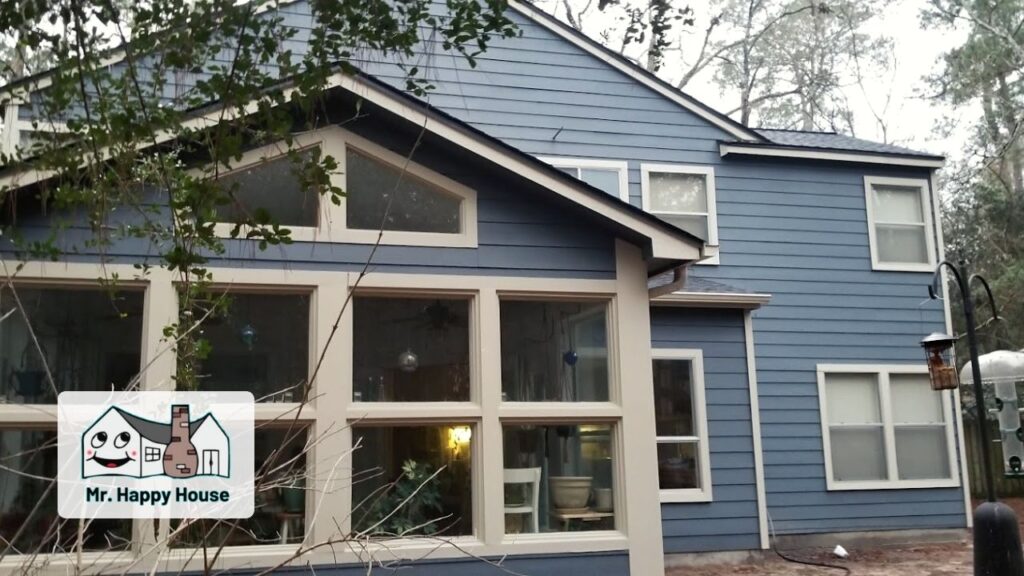
James Hardie siding emerges as a superior alternative offering enhanced durability, aesthetic versatility, and better energy efficiency. Its manufacturing process results in a product that stands up to harsh weather, fire, and insect damage, reducing the need for frequent maintenance and costly replacements. The added benefit of boosting a home’s resale value makes James Hardie siding a savvy investment for homeowners.
The initial costs and installation process may be higher and more complex than T1-11 siding, but the long-term benefits far outweigh these factors. With a professional siding contractor like Mr. Happy House, homeowners can ensure the proper installation of James Hardie siding, unlocking the full range of its benefits.
While each home improvement decision depends on individual circumstances and needs, considering the overall performance and impact of materials is key. James Hardie siding stands as a testament to the value of long-term investment in quality, offering homeowners a sustainable solution for their exterior home needs.
We hoped you loved this article on what is T1-11 siding and why you shouldn't have T1-11 siding on the exterior of your home, please share and tune in for more roofing, siding, and house painting content!
Our Services:













Best GAF Certified Roofers in The Woodlands, TX – Quality Roof Replacement, Gutters & Siding
Best GAF Certified Roofers in The Woodlands, TX – Quality Roof Replacement, Gutters & Siding Best GAF Certified Roofers in The Woodlands, TX – Quality
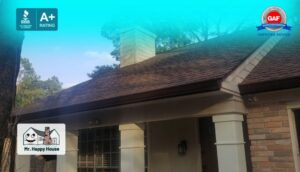
Are Gutters Part of the Roofing System?
Are Gutters Part of the Roofing System? Are Gutters Part of the Roofing System? When it comes to home maintenance, gutters often seem like a

Why James Hardie is The Best Option for Home Siding
Why James Hardie is The Best Option for Home Siding Why James Hardie is The Best Option for Home Siding James Hardie stands out whether











